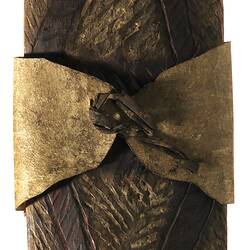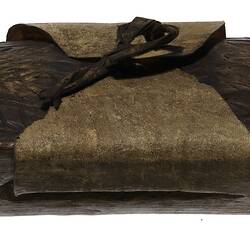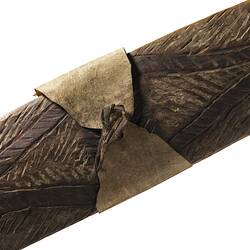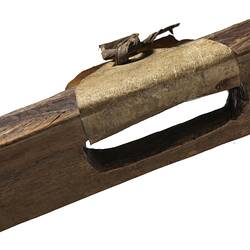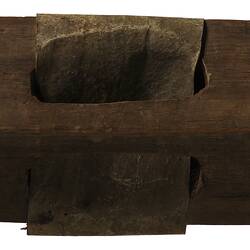Summary
This Mulga (shield) was collected by William Goodall, who was the Manager of Coranderrk Aboriginal Mission from 1869 to 1882 and Framlingham Aboriginal Mission from 1882 to 1889. Unfortunately its exact provenance is unknown and the maker was not recorded. The incised designs are typical of south-eastern Aboriginal art styles and the fact the collector was based in Victoria make it likely the mulga came from within this region.
Mulga were used as a defensive weapon during single, close combat against handheld weapons such as clubs and throwing sticks. They were usually made from local hardwood timbers such as Boxwood, Red Ironbark and Yellow Gum.
This particular Mulga has a piece of animal skin secured around the centre of the shield, through the hole provided by the handle. Many Mulga and Kul-luk (shield) featured a piece of possum skin or fur around the handle for the purpose of preventing injury to the knuckles when holding the shield, and also to ensure a firm grip during battle.
Local Name
Mulga
Physical Description
This long, narrow, triangular profile shield has a handle carved from a square cavity in the centre of the undersurface of the shield. A wide rectangular strip of ethnographic skin material, possibly rawhide, has been passed under the handle and around the shield at this point. This strip is fastened on the front of the shield, where a narrow strip of printed brown fabric is tied through a hole in each overlapping end of the rawhide strip. The upper surface of the shield is decorated with overall carving, comprising two parallel wavy lines internally filled with slanted score lines which have been filled with reddish brown paint. These parallel lines are surrounded by slanted scores in the wood which are filled with what appears to be a white or light coloured pigment, which has possibly been extended with soil. The shield label reads '49209 Shield. 1955 Aust. Mrs. B. Kruger.'
Significance
The front of the shield was decorated with meticulously incised design, characteristic of Victorian Aboriginal art. These lines were carefully carved using a sharp implement such as piece of flint or volcanic glass, or more commonly, a possum-tooth engraver.
Intricate designs in wood characterise the visual culture of south-eastern Australian Aboriginal people in the 19th century. The designs on all types of shields were infinitely variable, and no two are exactly the same. These designs are also used on tree carvings, possum-skin cloaks, and wooden implements and painted on the bodies of dancers. Like other art forms in the south-east the meaning of the designs is thought to relate to individual and group identity. Shields were also viewed as having innate power, and an old shield that had 'won many fights' was prized as an object of trade.
More Information
-
Object/Medium
Shield
-
Maker
-
Locality
-
Date Produced
-
Collector
-
Date Collected
-
Object Measurements
900 mm (Length), 110 mm (Width), 70 mm (Height)
-
Classification
-
Date Made
-
Maker
-
Clan/Language Group
-
Place Made
-
Indigenous Region
-
Keywords
-
Type of item
-
Discipline
-
Category
-
Collecting Areas

